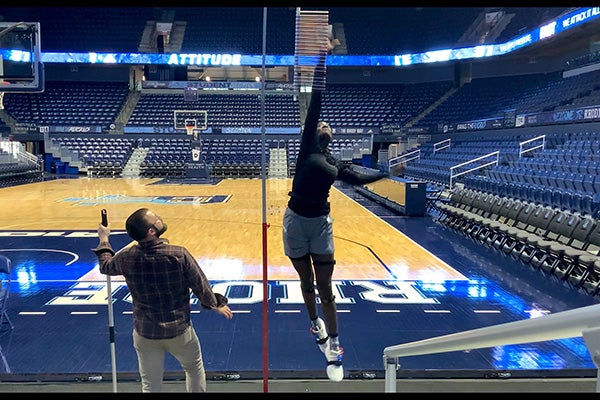Professor Ryan Chapman and student Dolly Cairns are studying whether foot anatomy impacts student athlete movement, performance, injury risk
The University of Rhode Island women’s basketball team recently completed a historic season, winning 26 games enroute to a regular season Atlantic 10 championship and a run to the Super 16 of the WNIT national tournament.
While the Rams were stomping their opponents on the court this season, they were also stomping around for science. Throughout the season, the team was participating in a biomechanics study in the Ryan Center and the Kinesiology Department’s Biomechanics and Wearables Laboratory to examine foot anatomy, and whether that anatomy affects movement, performance and a propensity for injuries.
The study is the brainchild of Professor Ryan Chapman and Catherine “Dolly” Cairns, former shooting guard and co-captain of the URI Women’s basketball team. In the spring of 2022, Cairns took Chapman’s Introductory Biomechanics course and became interested enough in the discipline to join him in a research study.
“Dolly and I recognized significant anatomic variability on the basketball team,” Chapman said about developing the research plan, prompting the pair to approach Head Coach Tammi Reiss, who immediately supported the project.
The overarching goal is to determine whether differences in the anatomy of the foot impact performance and contribute to injury. “I have a really high arch and have had a ton of nagging injuries like ankle rolls,” Cairns said. “So, I’m really interested in how arch height affects basketball players and how they move. I think if you have a higher arch, you’re more prone to ankle rolls. We’re trying to validate through research.”
On the court, Chapman and Cairns have been running the student-athletes through typical basketball moves—running, jumping, pivoting, shooting. They attached wearable sensors to each player to measure joint angles, acceleration and velocity. The players also wore force measuring insoles in their shoes to measure how much force the foot exerts during those typical basketball movements. Back in the kinesiology laboratory in Independence Square, the players were equipped with wearable sensors, EMG to monitor muscle activity and motion capture sensors to analyze their movements during similar activities.
Chapman and Cairns use sensing modalities to measure how joints move in space and how much load is applied through the feet during different movements. The force insoles in sneakers break down where pressure is applied on the forefoot, midfoot and rear-foot.
“Is there a connection with how a foot is built – its anatomy — and how they move, specifically with the women’s basketball team?” Chapman said. “Dolly has been collecting data all season long, looking at the foot anthropometrics and seeing if it has any connection to how they move.”
Preliminary findings of the study indicate that there in fact does seem to be some connection between how high the foot arch is and performance. Specifically, individuals with higher arches tended to have lower vertical jump performance, a standard metric used to evaluate basketball players.
“Although the correlation was moderate in this cohort, for every one-centimeter increase in arch height, we saw a reduction of around six centimeters in vertical jump performance. That’s greater than a two-inch reduction in vertical,” Chapman said. “We hope this type of information can give coaches, trainers and athletes a better idea of how to evaluate, train and keep athletes injury-free.”
Cairns has been conducting six data collection sessions with most players on the team at various times throughout the season. She continues to gather the data, and plans to continue the study going forward. With Chapman as a mentor, she will graduate this summer with a bachelor’s degree in kinesiology from URI and will be pursuing a graduate degree after commencement.
Chapman directs the Biomechanics and Wearables Laboratory, where the focus of his research efforts is on developing and utilizing novel wearable technology to evaluate a variety of populations (such as patients with arthritis, expectant mothers, and athletes). He co-teaches all biomechanics curriculum with Professor Susan D’Andrea and has worked actively to increase access to STEM opportunities for individuals typically under-represented in biomechanics.

